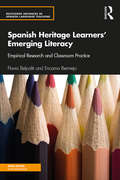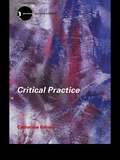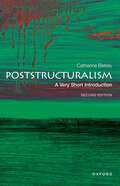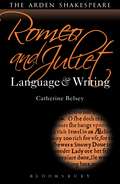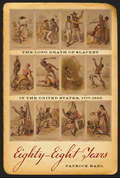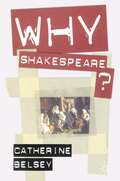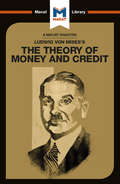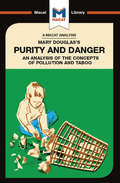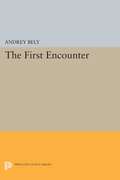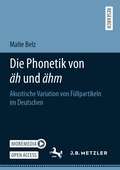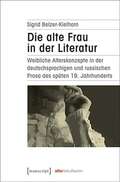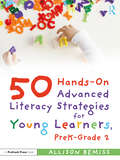- Table View
- List View
Spanish Heritage Learners' Emerging Literacy: Empirical Research and Classroom Practice (Routledge Advances in Spanish Language Teaching)
by Flavia Belpoliti Encarna BermejoSpanish Heritage Learners' Emerging Literacy: Empirical Research and Classroom Practice introduces a comprehensive, multi-level empirical study on the writing abilities of Spanish Heritage Learners at the beginner level; the findings guide a broad selection of instructional activities and pedagogical resources to support writing development in the heritage language classroom. This is the first book dealing exclusively with writing competence among Spanish Heritage Language Learners through the integration of empirical evidence and instructional perspectives to address core questions on heritage language literacy. In addition to the in-depth analysis of Spanish production—spelling, verb usage, grammatical features, vocabulary, and discourse organization—the volume revises the latest perspectives within the Heritage Language Education field, and provides effective teaching approaches, innovative classroom implementations, and up-to-date resources. This versatile volume, designed for researchers and practitioners in the fields of Bilingual Education, Language Teaching Methods, and Heritage Language Pedagogy, integrates empirical evidence, global perspectives on heritage language teaching, and suggestions for further research.
Spanish Heritage Learners' Emerging Literacy: Empirical Research and Classroom Practice (Routledge Advances in Spanish Language Teaching)
by Flavia Belpoliti Encarna BermejoSpanish Heritage Learners' Emerging Literacy: Empirical Research and Classroom Practice introduces a comprehensive, multi-level empirical study on the writing abilities of Spanish Heritage Learners at the beginner level; the findings guide a broad selection of instructional activities and pedagogical resources to support writing development in the heritage language classroom. This is the first book dealing exclusively with writing competence among Spanish Heritage Language Learners through the integration of empirical evidence and instructional perspectives to address core questions on heritage language literacy. In addition to the in-depth analysis of Spanish production—spelling, verb usage, grammatical features, vocabulary, and discourse organization—the volume revises the latest perspectives within the Heritage Language Education field, and provides effective teaching approaches, innovative classroom implementations, and up-to-date resources. This versatile volume, designed for researchers and practitioners in the fields of Bilingual Education, Language Teaching Methods, and Heritage Language Pedagogy, integrates empirical evidence, global perspectives on heritage language teaching, and suggestions for further research.
Image of a Man: The Journal of Keith Vaughan (Liverpool English Texts and Studies #77)
by Alex Belsey‘I want to know what I am, what I want, what I can do, what is real, what is lovely.’ The post-war British artist Keith Vaughan (1912–77) was not only a supremely accomplished painter; he was an impassioned, eloquent writer. Image of a Man is the first book to provide a comprehensive critical reading of Vaughan’s extraordinary journal, which spans thirty-eight years and sixty-one volumes to form a major literary work and a fascinating document of changing times. From close textual analysis of the original manuscripts, this book uncovers the attitudes and arguments that shaped and reshaped Vaughan’s identity as a man and as an artist. It reveals a continual process of self-construction through journal-writing, undertaken to navigate the difficulties of conscientious objection, the complications of desire as a gay man, and the challenges of making meaningful art. By focussing on Vaughan’s journal-writing in the context of its many influences and its centrality to his art practice, Image of a Man offers not only a compelling new critical biography of a significant yet underappreciated artist, but also a sustained argument on the constructed nature of the ‘artist’ persona in early and mid-twentieth-century culture – and the opportunities afforded by journal and diary forms to make such constructions possible.
Critical Practice
by Catherine BelseyWhat is poststructuralist theory, and what difference does it make to literary criticism? Where do we find the meaning of the text: in the author's head? in the reader's? Or do we, instead, make meaning in the practice of reading itself? If so, what part do our own values play in the process of interpretation? And what is the role of the text? Catherine Belsey considers these and other questions concerning the relations between human beings and language, readers and texts, writing and cultural politics. Assuming no prior knowledge of poststructuralism, Critical Practice guides the reader confidently through the maze of contemporary theory. It simply and lucidly explains the views of key figures such as Louis Althusser, Roland Barthes, Jacques Lacan and Jacques Derrida, and shows their theories at work in readings of familiar literary texts. Critical Practice argues that theory matters, because it makes a difference to what we do when we read, opening up new possibilities for literary and cultural analysis. Poststructuralism, in conjunction with psychoanalysis and deconstruction, makes radical change to the way we read both a priority and a possibility. With a new chapter, updated guidance on further reading and revisions throughout, this second edition of Critical Practice is the ideal guide to the present and future of literary studies.
Critical Practice
by Catherine BelseyWhat is poststructuralist theory, and what difference does it make to literary criticism? Where do we find the meaning of the text: in the author's head? in the reader's? Or do we, instead, make meaning in the practice of reading itself? If so, what part do our own values play in the process of interpretation? And what is the role of the text? Catherine Belsey considers these and other questions concerning the relations between human beings and language, readers and texts, writing and cultural politics. Assuming no prior knowledge of poststructuralism, Critical Practice guides the reader confidently through the maze of contemporary theory. It simply and lucidly explains the views of key figures such as Louis Althusser, Roland Barthes, Jacques Lacan and Jacques Derrida, and shows their theories at work in readings of familiar literary texts. Critical Practice argues that theory matters, because it makes a difference to what we do when we read, opening up new possibilities for literary and cultural analysis. Poststructuralism, in conjunction with psychoanalysis and deconstruction, makes radical change to the way we read both a priority and a possibility. With a new chapter, updated guidance on further reading and revisions throughout, this second edition of Critical Practice is the ideal guide to the present and future of literary studies.
A Future for Criticism
by Catherine BelseyA Future for Criticism considers why fiction gives so much pleasure, and the neglect of this issue in contemporary criticism. Offers a brief, lively, and accessible account of a new direction for critical practice, from one of Britain's most prominent literary theorists and critics Proposes a new path for future criticism, more open to reflecting on the pleasures of fiction Written in a clear, jargon-free style, and illustrated throughout with numerous examples
A Future for Criticism (Wiley-blackwell Manifestos Ser. #40)
by Catherine BelseyA Future for Criticism considers why fiction gives so much pleasure, and the neglect of this issue in contemporary criticism. Offers a brief, lively, and accessible account of a new direction for critical practice, from one of Britain's most prominent literary theorists and critics Proposes a new path for future criticism, more open to reflecting on the pleasures of fiction Written in a clear, jargon-free style, and illustrated throughout with numerous examples
Poststructuralism: A Very Short Introduction (Very Short Introductions)
by Catherine BelseyVery Short Introductions: Brilliant, Sharp, Inspiring Poststructuralism challenges traditional ways of thinking about human beings and our relation to the world. Language, meaning, and culture are all reappraised, and with them assumptions about what it's possible for us to know. More interested in posing sharply focused questions than in reassuring with certainties, its theorists tend to clarify the options, while leaving them open to debate. At once sceptical towards inherited authority and positive about future possibilities, poststructuralism asks above all that we reflect on its findings. In this Very Short Introduction, Catherine Belsey traces the key arguments that have led poststructuralists to challenge traditional theories of language and culture. In this new edition, such well-known figures as Barthes, Foucault, and Derrida are joined by less famous theorists, and examples are drawn from both high art and popular culture. Shakespeare features alongside advertising and Christmas cards, as well as Lewis Carroll, Marcel Duchamp, Toni Morrison, and the tantalizing lithographs of M. C. Escher. ABOUT THE SERIES: The Very Short Introductions series from Oxford University Press contains hundreds of titles in almost every subject area. These pocket-sized books are the perfect way to get ahead in a new subject quickly. Our expert authors combine facts, analysis, perspective, new ideas, and enthusiasm to make interesting and challenging topics highly readable.
Poststructuralism: A Very Short Introduction (Very Short Introductions)
by Catherine BelseyVery Short Introductions: Brilliant, Sharp, Inspiring Poststructuralism challenges traditional ways of thinking about human beings and our relation to the world. Language, meaning, and culture are all reappraised, and with them assumptions about what it's possible for us to know. More interested in posing sharply focused questions than in reassuring with certainties, its theorists tend to clarify the options, while leaving them open to debate. At once sceptical towards inherited authority and positive about future possibilities, poststructuralism asks above all that we reflect on its findings. In this Very Short Introduction, Catherine Belsey traces the key arguments that have led poststructuralists to challenge traditional theories of language and culture. In this new edition, such well-known figures as Barthes, Foucault, and Derrida are joined by less famous theorists, and examples are drawn from both high art and popular culture. Shakespeare features alongside advertising and Christmas cards, as well as Lewis Carroll, Marcel Duchamp, Toni Morrison, and the tantalizing lithographs of M. C. Escher. ABOUT THE SERIES: The Very Short Introductions series from Oxford University Press contains hundreds of titles in almost every subject area. These pocket-sized books are the perfect way to get ahead in a new subject quickly. Our expert authors combine facts, analysis, perspective, new ideas, and enthusiasm to make interesting and challenging topics highly readable.
Romeo and Juliet: Language and Writing (Arden Student Skills: Language and Writing)
by Catherine BelseyArden Student Skills: Language and Writing offer a new type of study aid which combines lively critical insight with practical guidance on the critical writing skills you need to develop in order to engage fully with Shakespeare's texts. The books' core focus is on language: both understanding and enjoying Shakespeare's complex dramatic language, and expanding your own critical vocabulary, as you respond to his plays. Key features include: • an introduction considering when and how the play was written, addressing the language with which Shakespeare created his work, as well as the generic, literary and theatrical conventions at his disposal • detailed examination and analysis of the individual text, focusing on its literary, technical and historical intricacies • discussion of performance history and the critical reception of the work • a 'Writing matters' section in every chapter, clearly linking the analysis of Shakespeare's language to your own writing strategies in coursework and examinations Written by world-class academics with both scholarly insight and outstanding teaching skills, each guide will empower you to read and write about Shakespeare with increased confidence and enthusiasm. How to find something new to say about this most familiar of Shakespeare's plays? Catherine Besley shows you how to build your understanding by starting with a focus on key speeches before looking at Shakespeare's sources and showing how his use of them can inform a critical appreciation of the play. She goes on to examine the exquisite poetry in the play and to unpick its complex rhetoric as well as examining key productions and adaptations such as the classic Baz Lurhmann film.
Romeo and Juliet: Language and Writing (Arden Student Skills: Language and Writing #5)
by Catherine BelseyArden Student Skills: Language and Writing offer a new type of study aid which combines lively critical insight with practical guidance on the critical writing skills you need to develop in order to engage fully with Shakespeare's texts. The books' core focus is on language: both understanding and enjoying Shakespeare's complex dramatic language, and expanding your own critical vocabulary, as you respond to his plays. Key features include: • an introduction considering when and how the play was written, addressing the language with which Shakespeare created his work, as well as the generic, literary and theatrical conventions at his disposal • detailed examination and analysis of the individual text, focusing on its literary, technical and historical intricacies • discussion of performance history and the critical reception of the work • a 'Writing matters' section in every chapter, clearly linking the analysis of Shakespeare's language to your own writing strategies in coursework and examinations Written by world-class academics with both scholarly insight and outstanding teaching skills, each guide will empower you to read and write about Shakespeare with increased confidence and enthusiasm. How to find something new to say about this most familiar of Shakespeare's plays? Catherine Besley shows you how to build your understanding by starting with a focus on key speeches before looking at Shakespeare's sources and showing how his use of them can inform a critical appreciation of the play. She goes on to examine the exquisite poetry in the play and to unpick its complex rhetoric as well as examining key productions and adaptations such as the classic Baz Lurhmann film.
Shakespeare and the Loss of Eden: The Construction of Family Values in Early Modern Culture
by Catherine BelseyIn a harsh, uncaring world the family is valued as a source of warmth and stability. At the same time, we are increasingly compelled to recognize that families can be oppressive both physically and emotionally. Now for the first time in paperback, Catherine Belsey's richly illustrated account of Shakespeare's plays, in conjunction with early modern images of Adam and Eve, locates the construction of family values in cultural history and politics. She shows the pleasures and anxieties generated in the period by the domestication of desire, parental love and cruelty and the relations between siblings - and discusses how Shakespeare's plays explore these themes.
Why Shakespeare?
by Catherine BelseyWhy is Shakespeare as highly regarded now as he ever has been? This book's answer to this question counters claims that Shakespeare's iconic status is no more than an accident of history. The plays, Belsey argues, entice us into a world we recognize by retelling traditional fairy tales with a difference, each chapter providing a detailed reading.
Why Shakespeare?
by Catherine BelseyWhy is Shakespeare as highly regarded now as he ever has been? This book's answer to this question counters claims that Shakespeare's iconic status is no more than an accident of history. The plays, Belsey argues, entice us into a world we recognize by retelling traditional fairy tales with a difference, each chapter providing a detailed reading.
The Emergence of African American Literacy Traditions: Family and Community Efforts in the Nineteenth Century (Non-ser.)
by Phyllis M. Belt-BeyanThe ways in which the African American community learned to be proficient readers and writers during the 19th century were diverse, however, the greatest impact on literacy acquisition came from family and community efforts. African American arts, churches, benevolent societies, newspapers, literacy societies, and formal and informal schools supported literacy growth, and literacy growth in turn gave rise to national and international African American literacy traditions. The underlying motivations that gave shape to the nature of their literacy behaviors and events within family and community contexts and within national and global context are examined in detail here.The beginnings of African American literacy traditions would have failed had there not been intrinsic motivations, opportunities, and a need to use all of the language arts, reading, writing, speaking, listening, and viewing to maintain and protect what mattered most to them as a people. The institutionalization of these traditions into family and community rituals, including songs, prayers, letters, story telling, and the like gave a visibility to the African American in ways no other cultural knowledge could. Belt-Beyan traces the development of these literacy traditions, noting the parallel progression and transformation of Africans into African Americans, slaves into freepersons, and noncitizens into citizens.
James March's Exploration and Exploitation in Organisational Learning (The Macat Library)
by Padraig BeltonExploration and Exploitation is a key text for scholars and business practitioners interested in promoting economic well-being and sustainable growth. March’s work promotes the preservation of companies’ competitiveness and sustainability in the fluctuating market environment by maintaining a balance between exploration and exploitation processes. He explicates that this balance depends on the interchange between the adaptive capability of the company, predictability and consistency, competition, anticipations, level of risk, learning, socialization dynamics within the organization, and the overall environmental turbulence. These intricacies make March’s text invaluable.
James March's Exploration and Exploitation in Organisational Learning (The Macat Library)
by Padraig BeltonExploration and Exploitation is a key text for scholars and business practitioners interested in promoting economic well-being and sustainable growth. March’s work promotes the preservation of companies’ competitiveness and sustainability in the fluctuating market environment by maintaining a balance between exploration and exploitation processes. He explicates that this balance depends on the interchange between the adaptive capability of the company, predictability and consistency, competition, anticipations, level of risk, learning, socialization dynamics within the organization, and the overall environmental turbulence. These intricacies make March’s text invaluable.
Ludwig von Mises's The Theory of Money and Credit (The Macat Library)
by Padraig BeltonLudwig Von Mises’s 1912 contribution to the theory of monetary policy and the current prevailing consensus in modern economic liberalism, The Theory of Money and Credit, was a milestone achievement. The author’s familiarity with the historical literature on banking and credit allows him to present a coherent theoretical structure that links private exchange between individuals, business and banks to condition the markets affecting money and credit. Through its wider influence on liberal thinkers and politicians, the Theory of Money and Credit has become a classic reference for those seeking to understand the advance of economic liberalism since the 20th century.
Ludwig von Mises's The Theory of Money and Credit (The Macat Library)
by Padraig BeltonLudwig Von Mises’s 1912 contribution to the theory of monetary policy and the current prevailing consensus in modern economic liberalism, The Theory of Money and Credit, was a milestone achievement. The author’s familiarity with the historical literature on banking and credit allows him to present a coherent theoretical structure that links private exchange between individuals, business and banks to condition the markets affecting money and credit. Through its wider influence on liberal thinkers and politicians, the Theory of Money and Credit has become a classic reference for those seeking to understand the advance of economic liberalism since the 20th century.
Mary Douglas's Purity and Danger: An analysis of the concepts of pollution and taboo (The Macat Library)
by Padraig BeltonMary Douglas is an outstanding example of an evaluative thinker at work. In Purity and Danger: An Analysis of Concepts of Pollution and Taboo, she delves in great detail into existing arguments that portray traditional societies as “evolving” from “savage” beliefs in magic, to religion, to modern science, then explains why she believes those arguments are wrong. She also adeptly chaperones readers through a vast amount of data, from firsthand research in the Congo to close readings of the Old Testament, and analyzes it in depth to provide evidence that traditional and Western religions have more in common than the first comparative religion scholars and early anthropologists thought. First evaluating her scholarly predecessors by marshalling their arguments, Douglas identifies their main weakness: that they dismiss traditional societies and their religions by identifying their practices as “magic,” thereby creating a chasm between savages who believe in magic and sophisticates who practice religion.
Mary Douglas's Purity and Danger: An analysis of the concepts of pollution and taboo (The Macat Library)
by Padraig BeltonMary Douglas is an outstanding example of an evaluative thinker at work. In Purity and Danger: An Analysis of Concepts of Pollution and Taboo, she delves in great detail into existing arguments that portray traditional societies as “evolving” from “savage” beliefs in magic, to religion, to modern science, then explains why she believes those arguments are wrong. She also adeptly chaperones readers through a vast amount of data, from firsthand research in the Congo to close readings of the Old Testament, and analyzes it in depth to provide evidence that traditional and Western religions have more in common than the first comparative religion scholars and early anthropologists thought. First evaluating her scholarly predecessors by marshalling their arguments, Douglas identifies their main weakness: that they dismiss traditional societies and their religions by identifying their practices as “magic,” thereby creating a chasm between savages who believe in magic and sophisticates who practice religion.
The First Encounter
by Andrey Bely Nina Berberova Gerald JanacekFirst published in Russian in 1921 and never translated, Andrey Bely's long narrative poem—considered to be one of the great achievements of Russian Modernism—is translated to English here. A poet, critic, philosopher, and novelist, Bely was a leading figure among the Russian Symbolists, and The First Encounter is thought to be his greatest work in verse. The poem is autobiographical and reflects turn of-the-century Moscow with its mixture of entrenched positivism and new spiritualistic trends, cultural variety and the upheaval of the time.Originally published in 1979.The Princeton Legacy Library uses the latest print-on-demand technology to again make available previously out-of-print books from the distinguished backlist of Princeton University Press. These editions preserve the original texts of these important books while presenting them in durable paperback and hardcover editions. The goal of the Princeton Legacy Library is to vastly increase access to the rich scholarly heritage found in the thousands of books published by Princeton University Press since its founding in 1905.
Die Phonetik von äh und ähm: Akustische Variation von Füllpartikeln im Deutschen
by Malte BelzIn diesem Open-Access-Buch wird untersucht, welche akustischen Eigenschaften Füllpartikeln wie äh und ähm in spontansprachlichen Dialogen des Deutschen zeigen und welche linguistischen Kontexte dabei auf welche Weise ihre akustische Form beeinflussen. Malte Belz betrachtet hierfür die phonetischen Parameter Dauer, Tonhöhe, Vokalqualität sowie Phonationsmodus und analysiert den Einfluss dreier granular verschiedener Kontextebenen auf die Form: die Mikroebene enthält Annotationen der adjazenten Laut- oder Pausenumgebung, die Mesoebene erfasst Intonationsphrasen und auf der Makroebene sind dialogstrukturelle Einheiten wie Fragen oder Antworten annotiert.Der Intonationsphrasenkontext übt den deutlichsten Effekt auf Füllpartikeln aus – so ist am Phrasenanfang ihr Vokal offener, während am Phrasenende ihre Dauer länger und ihre Tonhöhe tiefer ist. Dieses Ergebnis wird komplementiert durch Effekte auf der Mikroebene, während der Einfluss der Dialogstruktur inkonsistent bleibt. Die vorliegende Untersuchung zeigt damit, dass die Realisierung von Füllpartikeln – wie andere Wörter auch – allgemeinen prosodischen Prinzipien folgt.
Die alte Frau in der Literatur: Weibliche Alterskonzepte in der deutschsprachigen und russischen Prosa des späten 19. Jahrhunderts (Alter(n)skulturen #12)
by Sigrid Belzer-Kielhorn»Alt sein«, »Frau sein« und »Alte Frau sein« haben in der deutschen und russischen Literatur ganz unterschiedliche Konnotationen. Stereotype Einordnungen wie erfolgreiches oder erfolgloses Alter(n) reichen hier als Beschreibungskriterien für weibliches Altern nicht aus. Sigrid Belzer-Kielhorn verdeutlicht, dass die Literatur ihre Möglichkeiten nutzt, herrschende Diskurse zu unterlaufen und damit Alternativen aufzuzeigen: Indem sie mit Bedeutungen spielt, öffnet sie den Raum, weibliches Altersleben als Wahl zwischen diversen Möglichkeiten zu begreifen. Als fiktive Entwürfe von Altersrealitäten haben die analysierten literarischen Texte rückbezüglich wieder Auswirkungen auf die gelebte Erfahrung des Alter(n)s.
50 Hands-On Advanced Literacy Strategies for Young Learners, PreK-Grade 2
by Allison Bemiss50 Hands-On Advanced Literacy Strategies for Young Learners, PreK–Grade 2 is your go-to resource for lessons, strategies, and activities to foster the key skills and thinking strategies needed to excel in literacy. The hands-on, minds-on literacy explorations in this book are designed to feel a lot like play, but are rooted in the foundational literacy practices that all young learners need. Packed with engaging and helpful reproducibles, each activity is thoughtfully laid out with skill(s), materials, introduction, hands-on task, and reflection sections to maximize student learning. Instructions on how to scaffold experiences for a wider range of ages and developmental readiness levels make this resource imminently flexible. Ideal for learners in grades PreK–2, this book is for teachers, curriculum coaches, parents, librarians, and community educators looking to work on target literacy skills.
